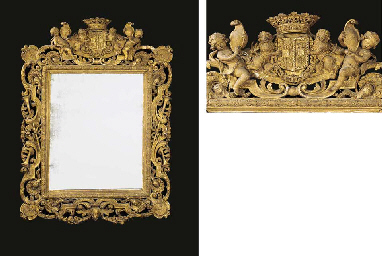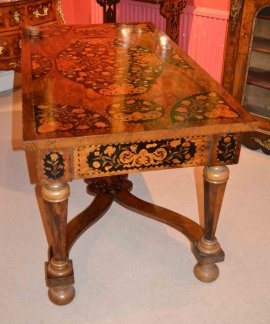The cabinet is usually made of oak, and then veneered with a variety of woods, for example walnut, palm and purple wood, with lacquer and ray-skin panels forming part of the inlay.
The cabinet stands on six turned, squared baluster legs joined by flat stretchers. A wealthy status symbol for its time, this cabinet is the earliest known example of Dutch furniture made using lacquer panels and polished ray-skin cut from an earlier Japanese coffer.
The original piece was probably Imported from the Netherlands by the Dutch East India Company, but was probably no longer fashionable.
The desirable exotic materials from the East would then have been removed and used to decorate a new, more fashionable, piece of antique furniture.

Giltwood Pier Table & Mirror
This is one of a pair of tables , each with a matching large mirror above. This heavily carved gilt table has a serpentine marble top and scrolled serpentine-panelled legs joined by a cross stretcher.
In the centre is a carved urn. The coat of arms of the original owner is carved into the top of the mirror frame. (Note: Table picture unavailable)

Doll's House
This doll's house was commissioned by Petronella Oortman, a very wealthy woman from Amsterdam. She ordered porcelain objects from China and had the city's handmade furniture makers and artists decorate the interior.
Costing as much as a townhouse along the canal, this was not a toy for children.
Its importance for the historian is in the design and placement of the furniture.
Dutch Oak & Marquetry Table
This table is typical of Low Countries' design, with square baluster legs and flat stretchers. Designed to stand against a wall, fitted furniture, only the visible surfaces are decorated with marquetry.

No comments:
Post a Comment